
1870s NYC: The Gilded Age Begins, Urban Enrichment & Industrial Progression
The 1870s marked a pivotal decade of transformation for New York City during the Gilded Age, initiating its evolution toward modern urbanization. This period was defined by groundbreaking infrastructural developments, most notably the commencement of the Brooklyn Bridge construction. This engineering marvel symbolized innovation and showcased the city’s progressive vision, setting the stage for New York City’s future as a global metropolis. The Gilded Age also laid the foundation for the cityscape we recognize today, with the emergence of new architectural styles and the expansion of the city’s geographical boundaries.
Culturally, New York City thrived with enriched diversity, driven by a surge in immigration during the 1870s. The city became a vibrant mosaic of cultures, languages, and traditions, significantly enhancing its social fabric. This influx of new inhabitants brought a wealth of cultural influences, reshaping New York City’s societal and cultural landscape.
During this time, New York City also faced challenges linked to rapid urban expansion, including housing shortages, sanitation issues, and the growing need for efficient public transportation. These challenges spurred extensive urban planning and public works projects, laying the groundwork for the modern New York City we recognize today.
In summary, the 1870s were a crucial period for New York City, characterized by remarkable infrastructural advancements and significant cultural transformation. The developments of this decade were instrumental in shaping the city’s future in terms of both architecture and society. The legacy of this period remains a pivotal chapter in New York City’s history, offering valuable insights into its evolution into a renowned global metropolis.
Timeline of New York City’s History in the 1870s
Discover surprising historical facts about The City That Never Sleeps—explore fun, educational insights into its history, population, iconic landmarks, and more, perfect for students, history enthusiasts, and anyone curious about NYC’s rich heritage.
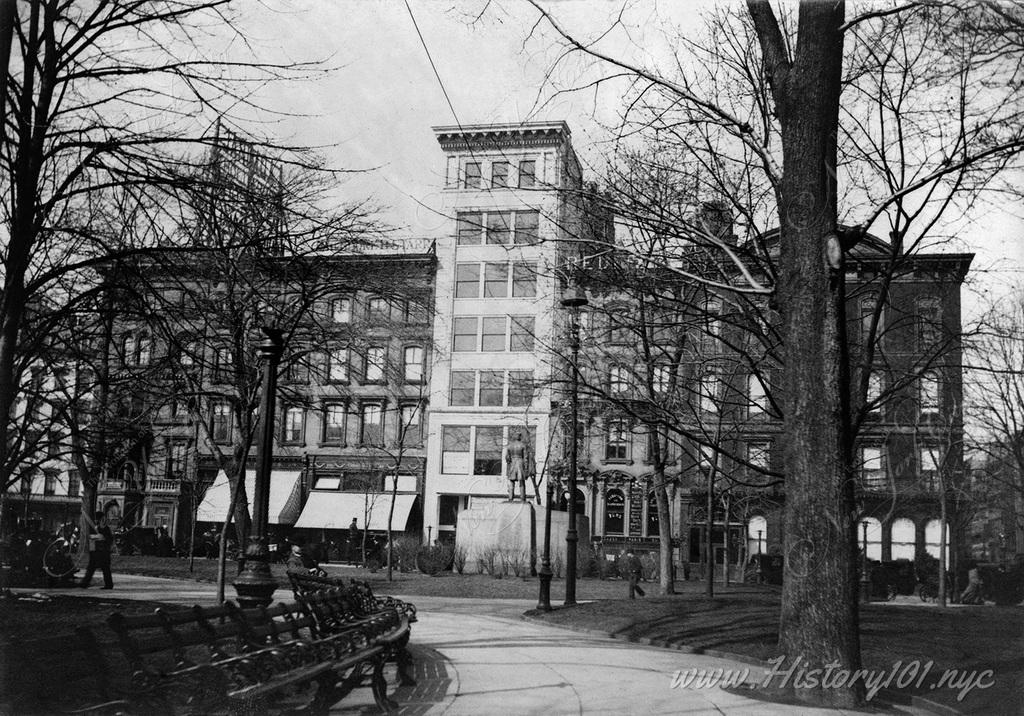
1870: Madison Square Park
Photograph of a row of buildings and storefronts taken from the perspective of Madison Square Park.
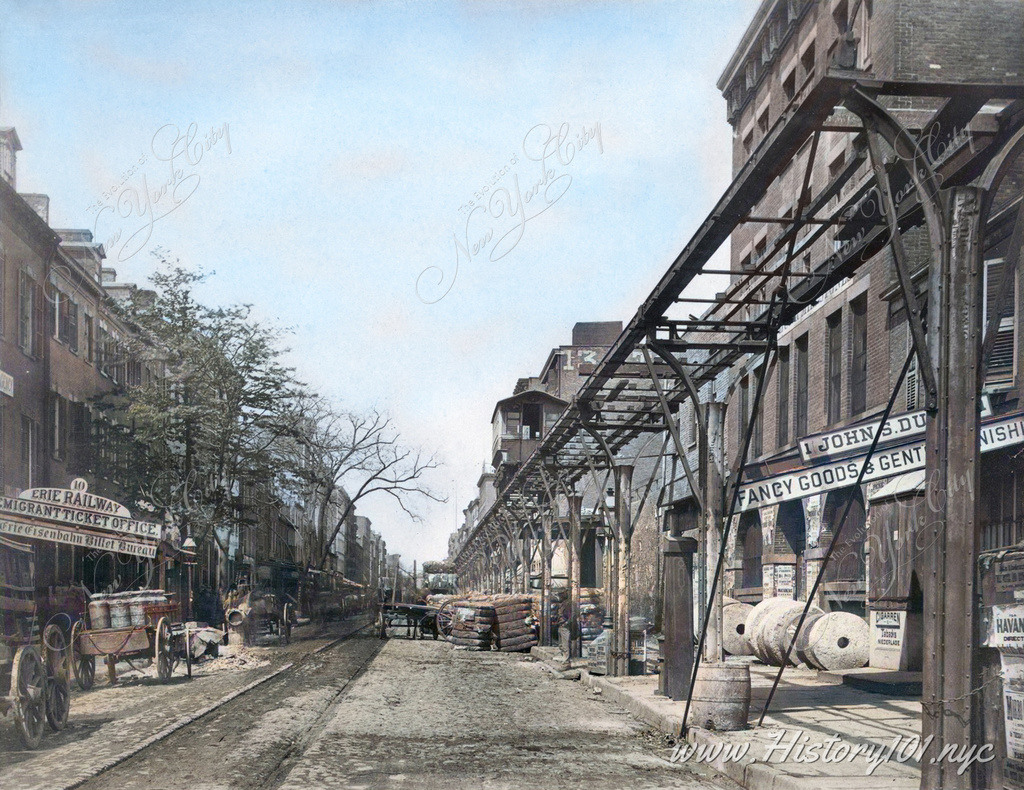
1870: Eire Railway on Greenwich Street
In the 1870s, Greenwich Street in New York City was a bustling hub of activity, with the Erie Railway Migrant Ticket Office and the elevated rail line adding to the vibrant atmosphere.
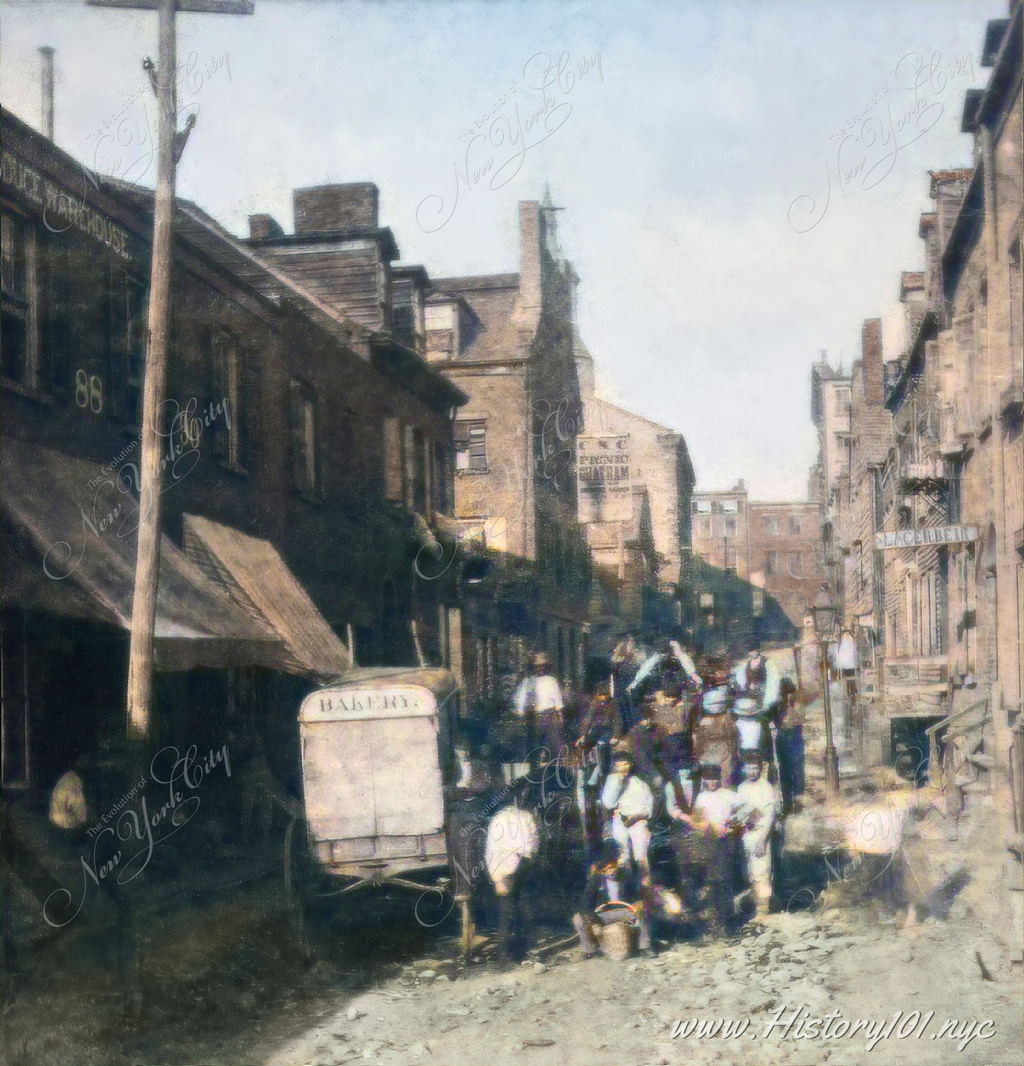
1870: The Five Points
A street view of the harsh realities of urban life in the infamous Five Points neighborhood in the year 1870.
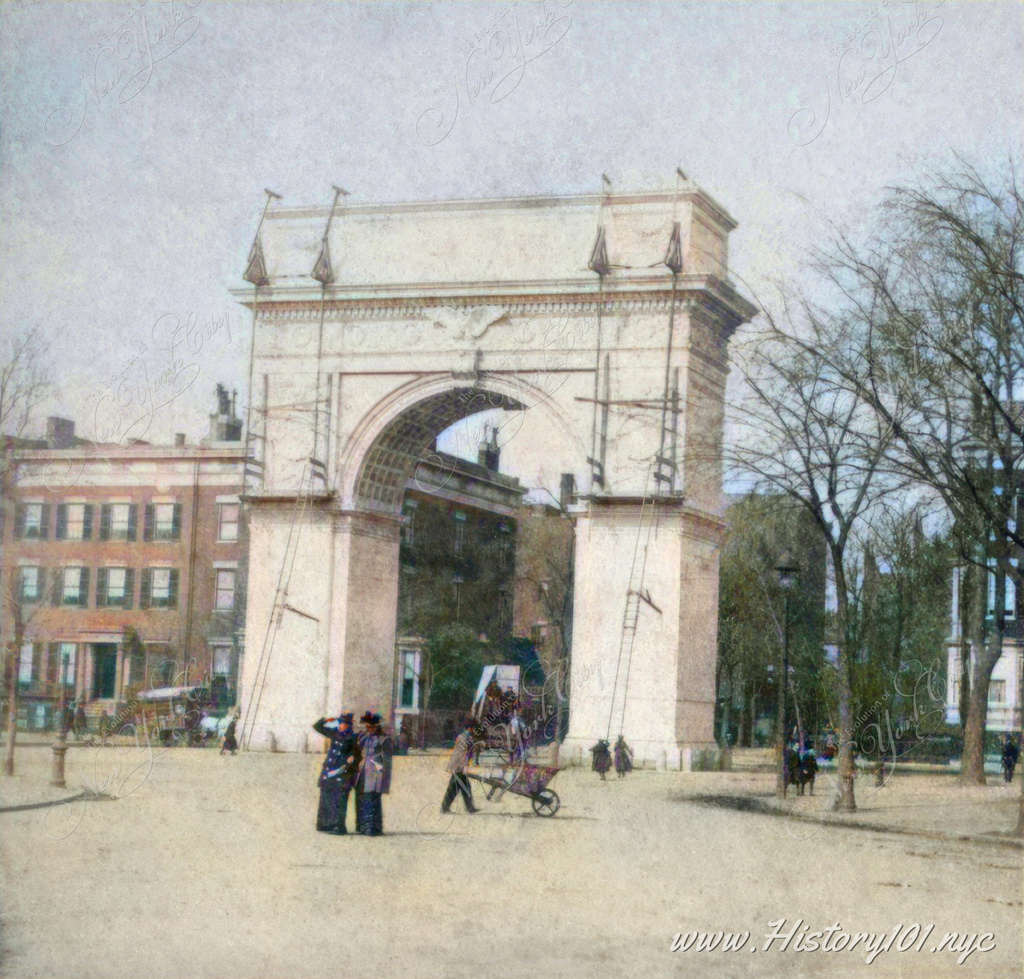
1870: Building the Washington Square Arch
Photograph of The Washington Square Arch in its final stages of construction. The arch is a historic monument located in Washington Square Park.
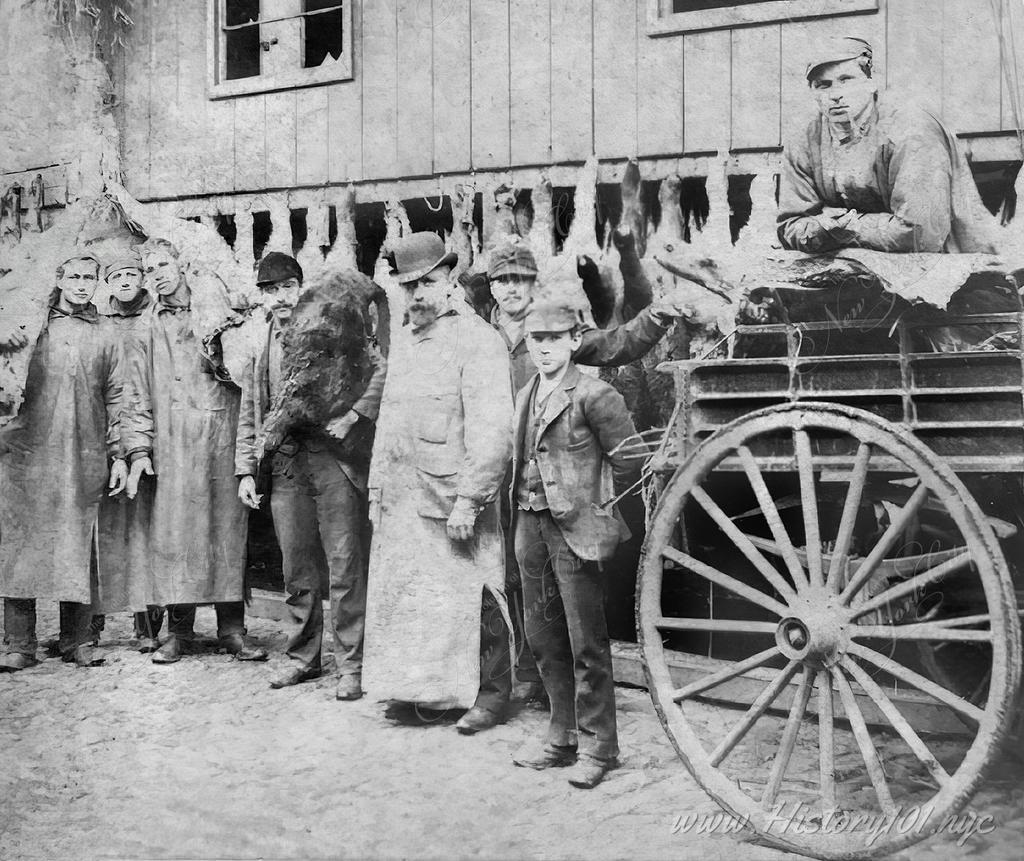
1870: Washington Market Butchers
A group of butchers pose together in front of their shop in what is known today as Tribeca.
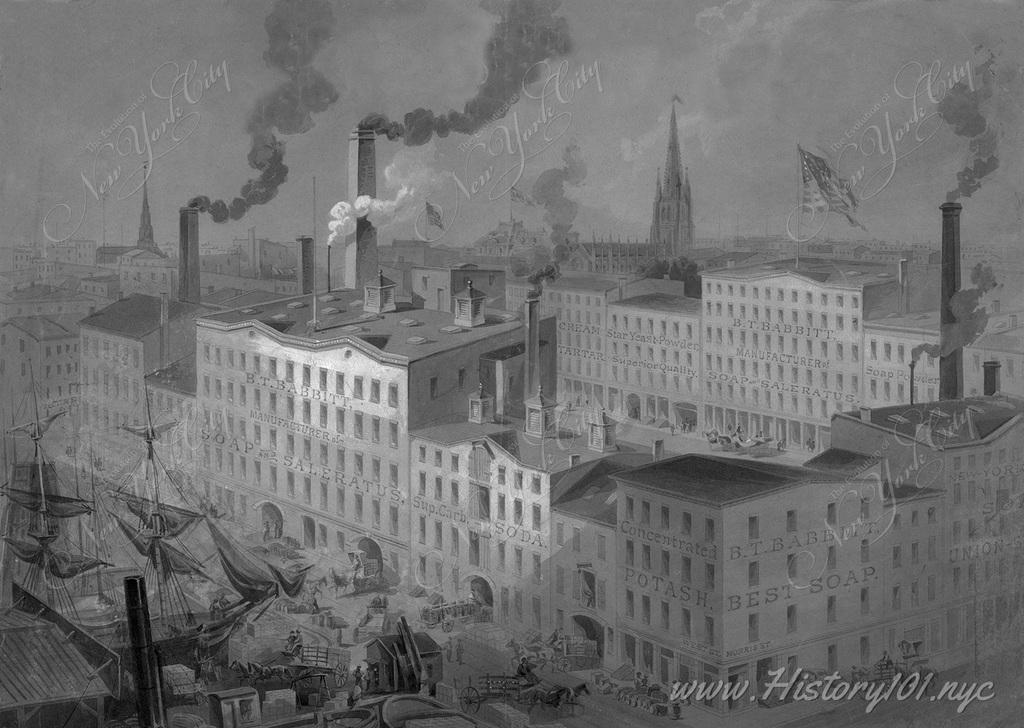
1870: B.T. Babbit Factory
Drawing by James A. Shearman featuring a soap factory in lower Manhattan, from West St. looking northeast, with the Equitable Building in the background.
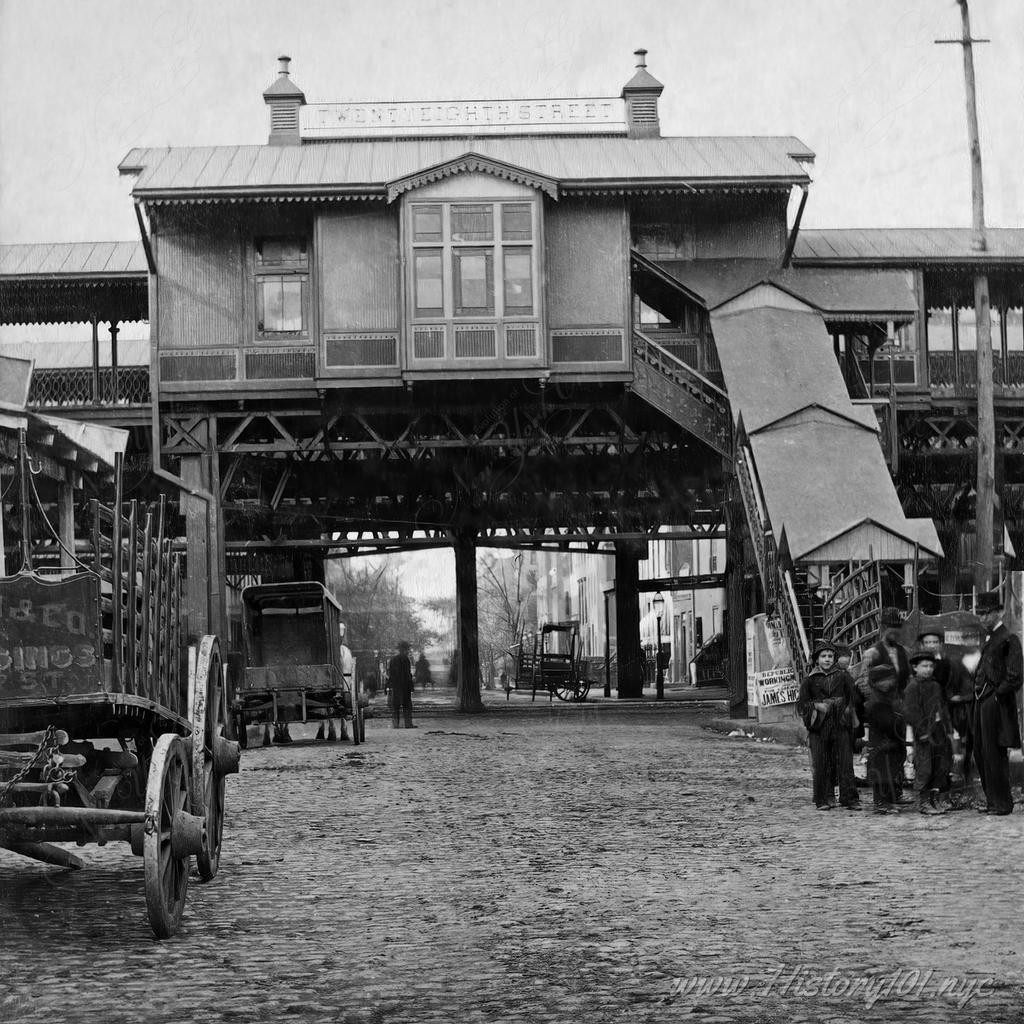
1870: Elevated Railroad Station
Photograph of an elevated railroad station constructed by the Manhattan Railway Company.
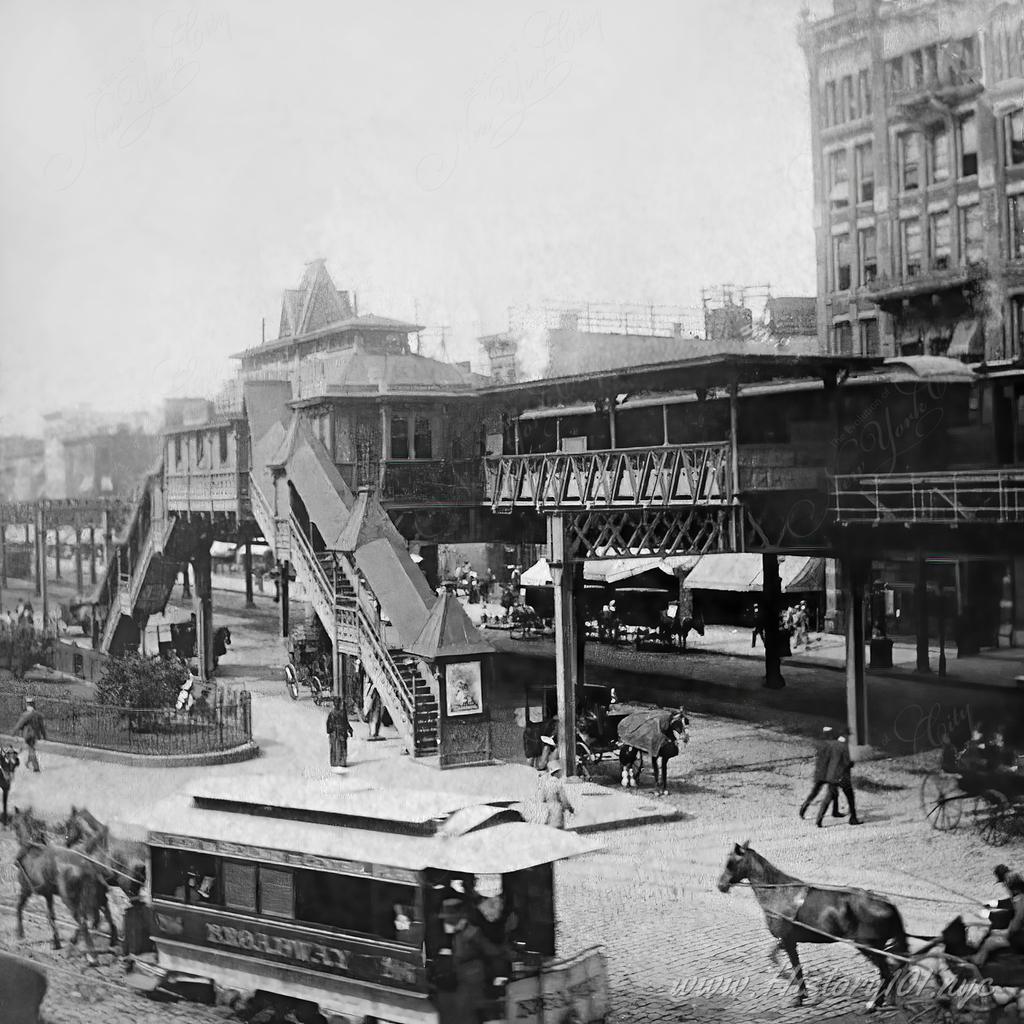
1870: Elevated Station on a Busy Street
View looking southwest from the intersection of 33rd Street and Broadway. The Sixth Avenue Elevated Railway is shown on Sixth Avenue where it crosses Broadway.
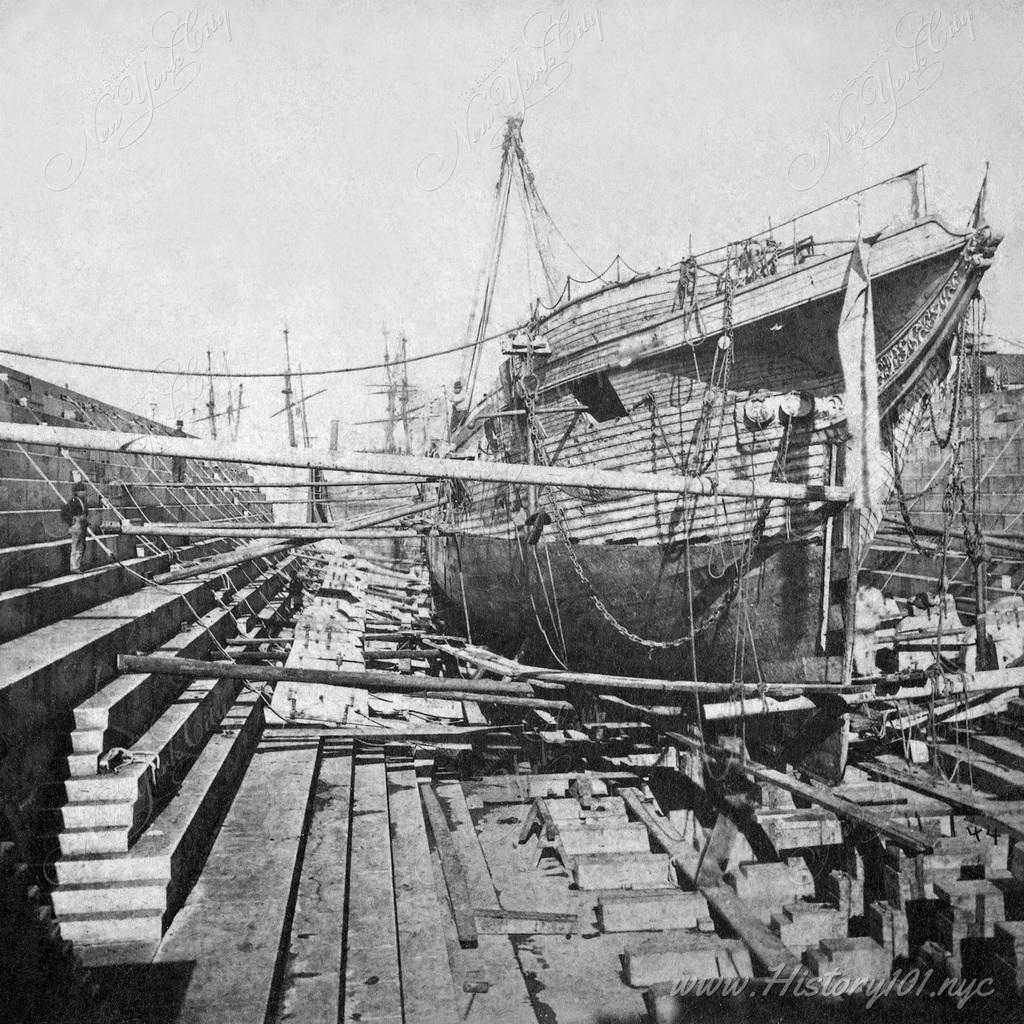
1870: Brooklyn Navy Yard
Silver photographic print of Brooklyn Navy Yard dry dock, which will be flooded as soon as the ship is completed and seaworthy.
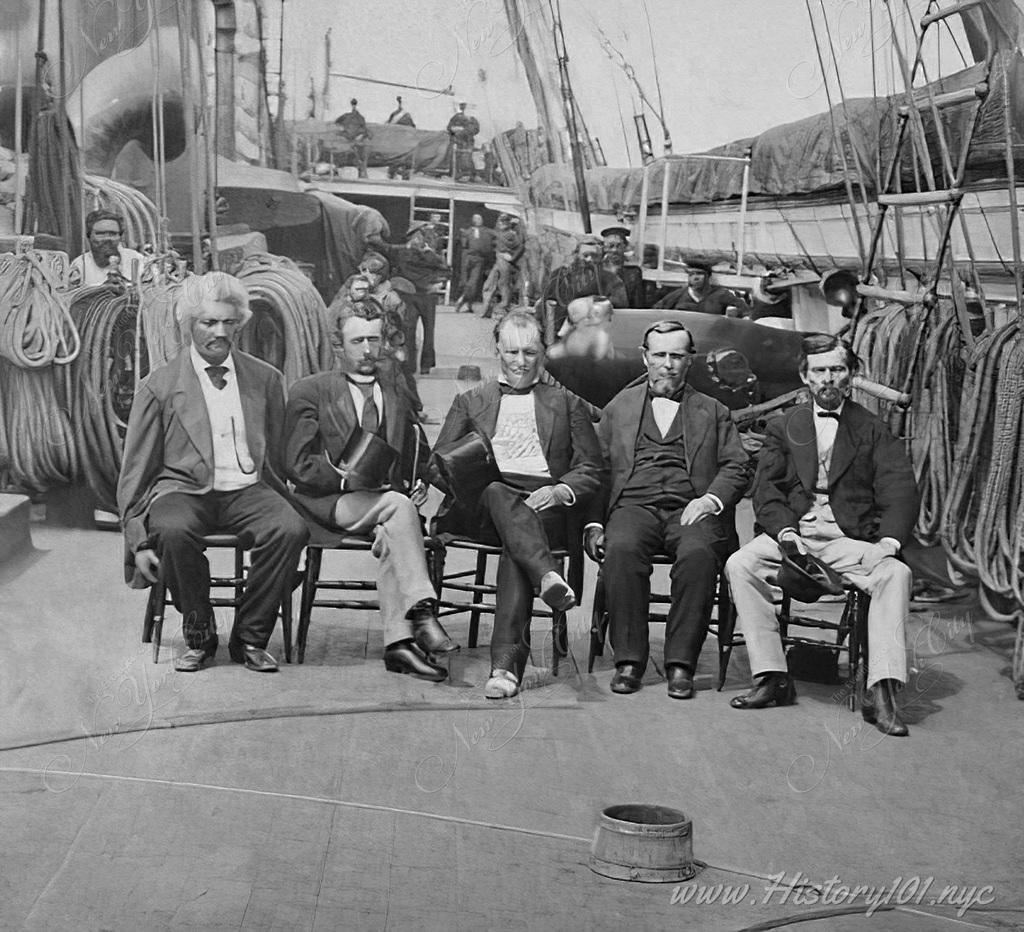
1871: Frederick Douglass at The Brooklyn Navy Yard
Frederick Douglass with The Commissioners to Santo Domingo, Brooklyn Navy Yard, January 1871
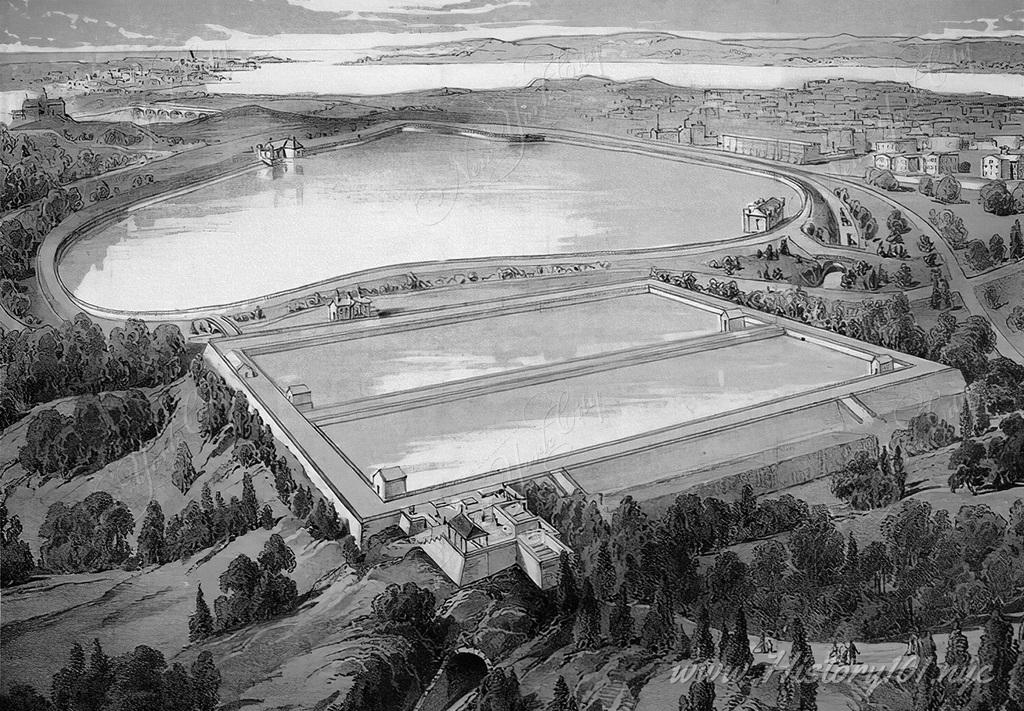
1871: Aerial View of Lake Manahatta to Onassis Reservoir: NYC's Water Evolution
Explore the transformation of NYC's Lake Manahatta into the Jacqueline Kennedy Onassis Reservoir, a journey from vital water source to Central Park
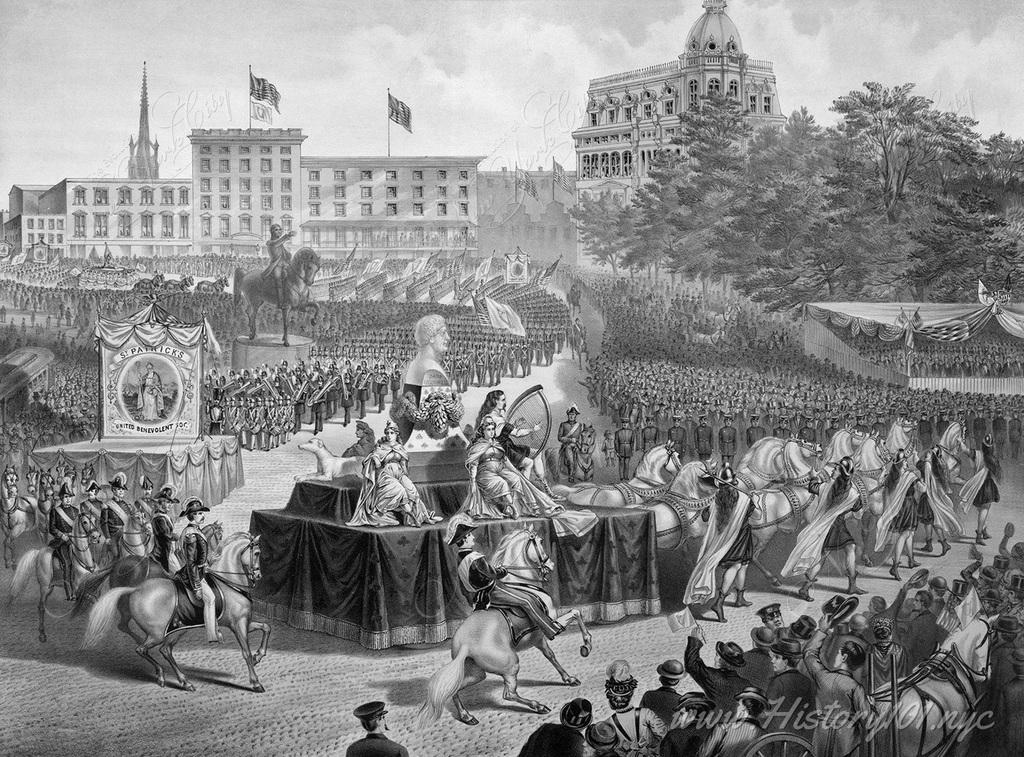
1871: St. Patrick's Day at Union Square
Print shows portion of a St. Patrick's Day parade at Union Square with a float in the center bearing a bust of Daniel O'Connell.
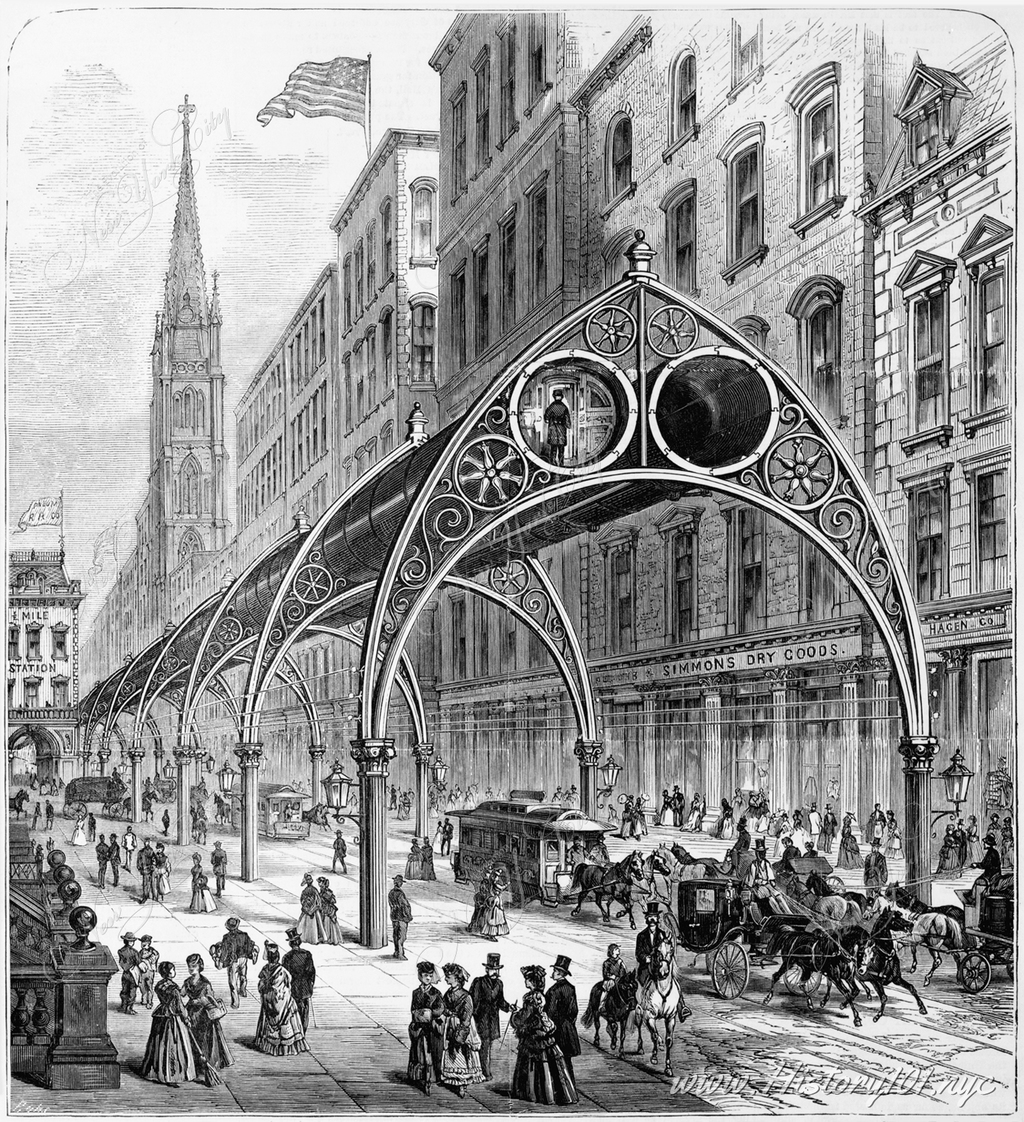
1871: Elevated Railroad
New York City - improved project of a covered atmospheric elevated railway for city transit, by Dr. R.H. Gilbert
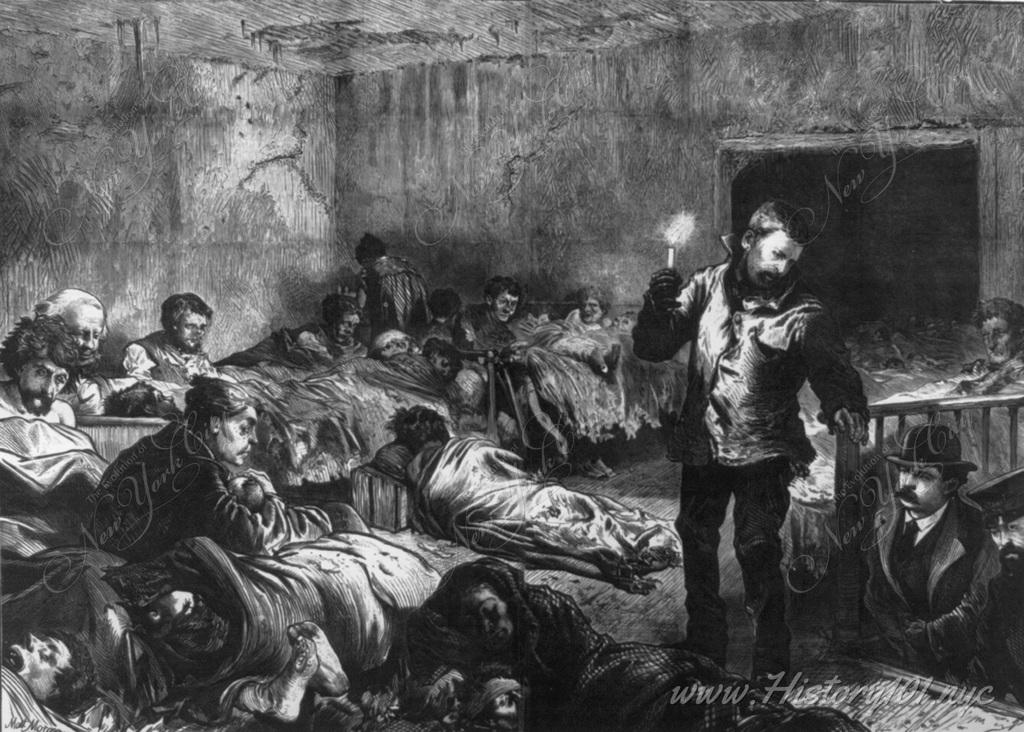
1872: Water Street Lodging for the Homeless
A portrait drawn from life by Matt Morgan depicting his midnight visit to one of the cheap lodging houses in Water Street.
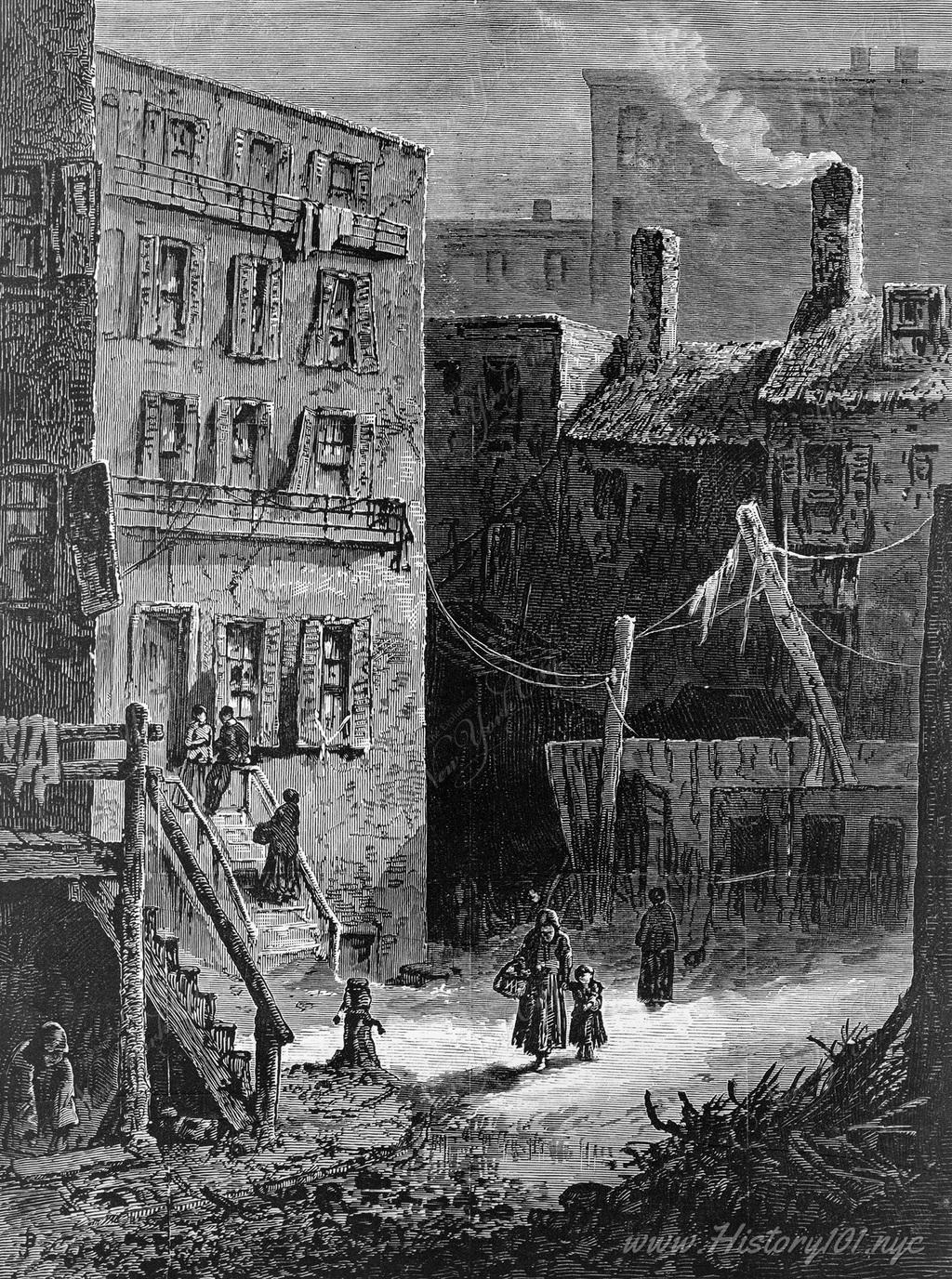
1872: Homeless New Yorkers at Five Points
Life sketches in the metropolis depicting the city's homeless poor during the early morning hours in Donovan Lane, near the Five Points.
Timeline of New York City: 1870-1880
1870: New York City's 1870 population milestone of 942,292, as recorded by the U.S. Census Bureau, affirmed its status as the United States' most populous city. This significant growth reflected the city's burgeoning role as a major urban and commercial hub, a trajectory amplified since the Erie Canal's 1825 completion.
The city's transportation infrastructure further evolved with the expansion of railroads, culminating in the Brooklyn Bridge's 1883 opening. Linking Manhattan and Brooklyn over the East River, the bridge was a crucial development, enhancing connectivity and streamlining the movement of people and goods, symbolizing New York City's dynamic progress and its pivotal role in urban development and commerce.
1870: Steinway & Sons opened its piano factory in Astoria, Queens,, marking a significant development in New York City's industrial history and establishing the company as a global leader in piano manufacturing. The factory was notable for employing skilled craftsmen and offering progressive worker benefits, including housing, medical care, and education, which played a crucial role in the community development of Astoria.
Conversely, Steinway Hall, which opened in 1866 on East 14th Street, became a cultural beacon in the city, hosting the New York Philharmonic and various significant events, thus symbolizing artistic excellence. William Steinway's impact was also pivotal in the development of Carnegie Hall, particularly in its acoustics and design. His efforts secured Andrew Carnegie's funding, further reinforcing the Steinway legacy in shaping New York's cultural landscape.
1870: Hunter College, initially named Normal College, was established and quickly became a pivotal educational institution in New York City, focusing on women's education and teacher training. This initiative addressed the city’s growing need for educational professionals during a period of rapid expansion. Alongside it, Hunter College High School, originally an all-girls institution, functioned as a practice teaching site for college students, enhancing practical training opportunities.
The establishment of Hunter College significantly advanced higher education in the city, particularly for women, providing them with vital opportunities for academic and professional development. Over time, Hunter College has evolved to reflect and enrich New York City's intellectual and cultural diversity, playing a vital role in shaping the public education system and remaining a key component of the city’s educational framework.
1870: Established in Baltimore by Frederick August Otto Schwarz and his brothers, the Schwarz Toy Bazaar, later rebranded as FAO Schwarz, marked its New York City debut in 1870. Initially offering high-quality European toys, it quickly stood out in the city's retail scene.
Evolving into a hallmark of NYC's culture and economy, FAO Schwarz gained fame for its deluxe toys and interactive attractions, like the iconic "dance-on" piano featured in "Big." Its flagship store on Fifth Avenue, launched in 1986, became a prime tourist attraction until 2015. In 2018, the brand made a comeback with a new flagship store at Rockefeller Center, continuing to enchant a diverse audience.
1870: The Lotos Club, founded in New York City, quickly became a vibrant hub for writers, journalists, and critics. Named after Tennyson's "The Lotos-Eaters," the club is deeply rooted in literary tradition and quickly established itself as a cornerstone for cultural and intellectual exchange, nurturing the arts and fostering discussions.
Integral to NYC's cultural fabric, the Lotos Club has served as a gathering place for prominent figures in arts and literature since its founding. Beginning in 1874, its celebrated "State Dinners" have honored various luminaries, enriching the city's heritage of intellectual and artistic dialogue. This tradition has solidified the club’s role in shaping New York's cultural and historical narrative.
1870: New York City's Central Park faced a major shift under the corrupt Tweed Ring in 1870, led by William "Boss" Tweed. They replaced the park's Board of Commissioners with the Department of Public Parks, a move central to their financial embezzlement scheme. This reshuffling signified the start of a significant misuse of city funds and a shift in the park's management, impacting the city's governance and financial integrity.
Peter B. Sweeny, a Tweed Ring member, took over as head of the new department, dismissing key figures like Frederick Law Olmsted and Calvert Vaux, Central Park's designers, and comptroller Andrew Haswell Green. This change was part of a larger plot involving Tweed, Mayor A. Oakey Hall, and Comptroller Richard B. Connolly, leading to the misappropriation of millions in public funds and altering NYC's political and financial landscape.
1870: The Metropolitan Museum of Art's origins date back to a proposal made by John Jay, a prominent American lawyer, during a Fourth of July gathering in Paris in 1866. Inspired by the assembly of his fellow countrymen, Jay envisioned a national institution dedicated to the arts. This idea laid the groundwork for one of New York City's most significant cultural landmarks. The museum was officially incorporated on April 13, a testament to Jay's vision and the collective effort of its founders to foster art appreciation and education.
The Metropolitan Museum of Art opened its doors to the public on February 20, 1872, in the Dodworth Building at 681 Fifth Avenue, before moving to its permanent site in Central Park in 1880. Since its inception, the Met has become a pivotal cultural institution in both American and global contexts, dedicated to bringing art and educational opportunities to the public. Today, it stands as one of the world's largest and most comprehensive art museums, contributing significantly to New York City's stature as a global center for arts and culture, attracting millions of visitors annually and enriching the cultural fabric of the city.
1870: New York City's elevated railway history began with the West Side and Yonkers Patent Railway, the precursor to the Ninth Avenue El, starting experimental operations on Greenwich Street in 1868. This marked the city's first foray into elevated rapid transit, initially using a cable-haul system to connect the Battery to Cortlandt Street. Transforming urban transportation, this line introduced an innovative mode of elevated travel, significantly influencing the city's transit development.
By February 14, the railway transitioned to regular passenger service, a key milestone in NYC's transit evolution. Its success spurred the growth of the city's elevated railway network, with the Third Avenue El, Second Avenue El, and Sixth Avenue El emerging subsequently, reshaping urban mobility and driving the city's development forward.
1870: New York City formed the Department of Docks and Ferries to streamline the management of its vital waterfront in 1870, including docks and ferry operations. This move was crucial for the city's role as a major commerce and transportation hub, addressing the need for organized management of its rapidly growing waterfront activities.
The department significantly influenced New York City's economic and infrastructural progress, handling planning, construction, and maintenance of waterfront facilities, while also promoting commercial activities. Over time, the department's functions evolved, eventually integrating into the New York City Economic Development Corporation, continuing its legacy in waterfront management and development.
1871: The Tweed Ring's corruption, led by William "Boss" Tweed, was exposed in 1871, reshaping New York City's governance. The Department of Public Parks, previously under Tweed's influence, was overtaken by former Central Park commissioners. This transition reinstated Andrew Haswell Green and rehired landscape architects Frederick Law Olmsted and Calvert Vaux, leading to the completion of Central Park and renovations of other key Manhattan parks like Madison Square and Union Square.
The scandal precipitated Boss Tweed's downfall. Arrested for the County Courthouse project's cost overrun from $250,000 to $12 million, his 1873 trial in the unfinished courthouse led to his conviction on 204 counts. Initially sentenced to 12 years, Tweed's term was reduced and ended in 1875, but he was rearrested and died in prison in 1878. This corruption, implicating Tammany Hall, prompted significant political reforms, transforming the city's political landscape.
1871: The cornerstone for the New York State Capitol in Albany was laid on June 24, initiating the construction of one of the most architecturally elaborate state capitols in the United States. This marked the beginning of a construction period that extended nearly 32 years due to the elaborate design, financial constraints, and political disputes that characterized the project. The Capitol was conceived to house the New York State government and has since been central to the state’s political life.
Since its completion, the New York State Capitol has become a key historical site that attracts tourists and educates citizens about New York’s legislative history. Its presence enhances Albany's tourism and offers numerous educational opportunities, showcasing the state’s rich political and cultural legacy. Functioning as the vibrant center of legislative activities, the Capitol embodies New York's historical significance and continues to host events that shape both state and national policies.
1871: The Orange Riots in New York City on July 12th, marked a violent clash between Irish Protestant and Catholic immigrants, triggered by a parade celebrating the Protestant victory in the 1690 Battle of the Boyne. This event, rooted in deep-seated sectarian divisions, provoked the Catholic community, leading to violent confrontations.
The deployment of the New York State National Guard failed to prevent violence, resulting in over 62 fatalities and numerous injuries. This tragedy underscored the city's ethnic and religious rifts, significantly impacting its approach to handling such conflicts and reflecting the complexities of its diverse, growing population.
1871: On July 30, the Staten Island Ferry "Westfield II" in New York City witnessed a catastrophic boiler explosion, claiming about 125 lives. This tragedy, involving mainly Manhattanites on a beach outing, stands as one of the city's deadliest maritime incidents. The disaster highlighted the critical need for robust safety measures in urban transportation, particularly for widely used ferries.
In response, intense scrutiny and reforms followed, focusing on mechanical safety and operational oversight for public vessels. These changes not only enhanced ferry travel safety but also set new standards for public transportation in the city, marking the "Westfield II" explosion as a turning point in New York City's maritime and transport history.
1871: Opened on October 1, the Grand Central Depot, located at 42nd Street and Park Avenue, revolutionized New York City's transportation, merging several railroad stations into a central hub for key railroads. This landmark, the forerunner of today's Grand Central Terminal, transformed the movement of people and goods, catalyzing the city's evolution into a metropolitan powerhouse. Its establishment reshaped the urban landscape and laid the foundation for economic growth.
Beyond facilitating transit, the depot spurred extensive urban development, evolving into an architectural and cultural icon by 1913 with the completion of the Grand Central Terminal. Symbolizing the city's progress and dynamism, it holds a pivotal place in New York City's history, marking a significant shift in urban transportation and development during the late 19th and early 20th centuries.
1871: Washington Square Park in Greenwich Village underwent a pivotal redesign, transitioning from a 19th-century marshland and military cemetery into a vibrant public space. This transformation was part of the urban green space enhancement movements, aiming to make the park more accessible and enjoyable for the public. The redesign included the addition of walkways, greenery, and leisure areas, establishing the park as a key cultural and social hub in New York City, a status it retains today.
Historically, from 1797 to 1820, the area served as a potter's field where over 20,000 indigent and unidentified New Yorkers were buried in mass graves. Despite its transformation into a lively public space, ghost tours and historical research continue to highlight the park's haunting legacy, with stories of eerie encounters reminding visitors of its past. This aspect of its history adds a profound layer to its identity, intertwining recreation with a poignant historical narrative, and illustrating the complex layers of urban spaces.
1871: The Salmagundi Club quickly emerged as a pivotal cultural institution in New York City, initially serving as a sketch club for artists before evolving into a prominent art hub in Greenwich Village. Rapidly becoming central to the city's artistic community, the club, hosted exhibitions and events that spurred artistic innovation, significantly contributing to the city's dynamic cultural milieu and playing a pivotal role in the American art scene.
The club’s influence has extended beyond fostering artistic innovation to preserving artistic heritage. Its historic clubhouse in Greenwich Village, recognized as an architectural landmark, has become a center for promoting art education and appreciation. The Salmagundi Club continues to profoundly impact New York City's cultural landscape, intertwining recreation and education, and enriching both the city's and the nation's artistic narrative.
1871: The National Rifle Association (NRA) was officially chartered on November 17, in the State of New York. Founded by Civil War veterans Colonel William C. Church and General George Wingate, the NRA was established primarily to "promote and encourage rifle shooting on a scientific basis." The founders were motivated by the poor marksmanship skills they observed during the war, and they aimed to improve national defense capabilities through better shooting training and competitions.
The establishment of the NRA in New York played a significant role in fostering recreational and competitive shooting sports within the state and nationally. By focusing on education and the scientific aspect of shooting, the NRA contributed to New York's rich tapestry of sports and outdoor activities, aligning with broader movements towards organized sports in America. This organization not only enhanced marksmanship skills but also contributed to community engagement and sport, reflecting New York’s historical and cultural development as a hub for diverse recreational activities.
1871: Moses F. Gale was granted a U.S. patent a patent for an "Improvement in Cigar Lighters" on November 21, highlighting a period of vibrant innovation in New York City. This invention is one of many that emerged from the city, showcasing its role as a hub for technological advancements and industrial growth during the 19th century. The patent underscores the creative spirit prevalent in New York during this era, contributing to its reputation as a center where novel ideas and inventions were both welcomed and encouraged.
Gale’s invention of the cigar lighter added to the conveniences that fueled local commerce and everyday life in New York City. Such innovations were not just technical achievements but also contributed significantly to the commercial landscape, enhancing the city's economic development. As New York continued to grow, the integration of such technologies played a crucial role in shaping its identity as a leading city in commerce, culture, and innovation, attracting inventors and entrepreneurs alike.
1871: Albert L. Jones made a groundbreaking contribution to packaging technology with his patent for corrugated paper, granted on December 19. This invention laid the foundation for modern corrugated cardboard, providing a durable and lightweight material that revolutionized the packaging and shipping industries. Originally designed for wrapping fragile items, corrugated paper offered enhanced protection and efficiency in transporting goods. The introduction of this material marked a significant advancement in packaging, highlighting New York City's role as a center of innovation and industrial progress in the late 19th century.
The impact of Jones's invention on New York City was profound, spurring economic growth and creating job opportunities. The burgeoning corrugated paper industry supported local manufacturing and logistics, improving packaging standards and facilitating more efficient shipping processes. The patent's recognition on December 19 solidified New York City's reputation as a hub of technological advancement. This development was instrumental in shaping the city's industrial landscape, underscoring its importance in the broader context of global innovation.
1872: New York City achieved a demographic landmark by reaching a population of 1 million in 1872, signifying its rapid 19th-century growth. This surge was fueled by natural increase and significant European immigration, drawn to the city's status as a major port and commercial hub. The diverse and expanding population mirrored the city's emergence as a vibrant, multicultural metropolis.
This population milestone catalyzed substantial urban development, including housing expansion, infrastructure enhancement, and public service improvement. New neighborhoods formed, transportation networks evolved, and the city's economic and cultural vibrancy intensified. Reaching 1 million residents not only marked New York City's growth but also underscored its transformation into a key global city, shaping its future trajectory as a hub of commerce, culture, and politics.
1872: Victoria Claflin Woodhull's nomination for U.S. President by the Equal Rights Party was a historic milestone in American politics. On May 10, at Apollo Hall in New York City, she became the first woman to seek the nation's highest office, decades before women gained the right to vote. A leading figure in the women's suffrage movement and an advocate for social reform, Woodhull's candidacy challenged gender norms and barriers, bringing significant attention to the fight for women's rights.
Woodhull's campaign not only advanced the women's rights movement but also cemented New York City's status as a focal point for progressive thought and activism. Her presidential bid spotlighted crucial issues of gender equality and women's political participation, influencing the cultural and political discourse of the time.
1872: The Metropolitan Museum of Art, a cornerstone of cultural excellence in New York City, first opened its doors on February 20. Originally housed in the Dodworth Building at 681 Fifth Avenue, this grand opening marked a significant milestone, reflecting the realization of a visionary proposal made by John Jay in 1866. The establishment of the Met was a pivotal moment in the city's history, setting the stage for a future as one of the world's premier cultural institutions.
Today, the Metropolitan Museum of Art is renowned globally for its extensive collection that spans 5,000 years of art from around the world, drawing millions of visitors annually. Located since 1880 in its iconic building on the eastern edge of Central Park, the Met continues to fulfill its mission of connecting people to creativity, knowledge, and ideas. This enduring institution not only enhances New York City's cultural landscape but also serves as a vital educational resource, enriching the lives of residents and tourists alike.
1872: Bloomingdale's was founded by Lyman and Joseph B. Bloomingdale, initially as a boutique on Third Avenue specializing in hoop-skirts. The establishment of this boutique marked the beginning of what would become an iconic department store in New York City. Initially focusing on a niche in women's fashion, the store later expanded its merchandise range to include a variety of products, adapting to broader market trends.
The significant growth of Bloomingdale's led to its relocation to the flagship store at 59th Street and Lexington Avenue in the early 20th century, transforming it into a major retail and fashion destination. Renowned for its designer brands and luxury goods, Bloomingdale's evolution reflects New York City's economic and cultural dynamism.
1872: Carl Fischer Music was founded by German immigrant Carl Fischer in New York City. Initially, it was a modest store selling music scores, instruments, and related materials. This establishment quickly became a pivotal enterprise in the city's music industry, renowned for its extensive selection and support for musicians and composers through publication and distribution. This contribution significantly enriched the musical culture in the U.S.
Beyond its retail operations, Carl Fischer Music has made substantial contributions to music education and performance in New York City. Its longevity and adaptability to changing times and technologies reflect the city's dynamic business and cultural fabric. A longstanding contributor to the local economy, particularly in retail and culture.
1872: Riverside Park was acquired by New York City's Department of Public Parks, valued for its scenic Hudson River views. The park began its transformation with a survey in 1873 by Frederick Law Olmsted, who is renowned for designing Central Park. Olmsted's plan for Riverside Park included a winding carriage drive along the ridge and a scenic overlook at 129th Street, capitalizing on the area's natural beauty.
Over the late 19th and early 20th centuries, the park's development continued, with walking paths added in the 1880s to enhance public enjoyment. Although initially limited in access due to the New York Central Railroad's right-of-way, a significant redevelopment in the 1930s of the West Side shoreline greatly improved the park's integration with New York City's urban fabric.
1872: The establishment of the first Shriners Temple, known as Mecca Temple, marked a significant milestone in the history of the Shriners organization. On September 26, in New York City, the Mecca Temple became the inaugural meeting place for the Ancient Arabic Order of the Nobles of the Mystic Shrine. This event laid the foundation for the Shriners as a fraternal organization distinguished by its emphasis on fun, fellowship, and distinctive red fez hats. The Mecca Temple served as a central hub for the group's activities, promoting camaraderie among members and fostering a strong sense of community.
The creation of the Mecca Temple in New York City had a profound impact on the city's cultural and philanthropic landscape. As the birthplace of the Shriners, New York City became a focal point for the organization's charitable initiatives, including the later establishment of Shriners Hospitals for Children in 1922. These hospitals, known for providing medical care to children regardless of their ability to pay, exemplified the Shriners' commitment to social welfare and community support. The Mecca Temple's establishment reinforced New York City's reputation as a center for innovative and impactful social endeavors, contributing to its legacy as a leader in philanthropy and community service.
1872: New York City faced a significant winter storm that brought 18 inches of snowfall. This event, occurring on December 26, was the fourth-largest recorded snowfall in the city's history at that time. The massive accumulation disrupted transportation and daily activities, posing a significant challenge to the city's infrastructure. As New Yorkers dealt with the impact of this severe weather, the event highlighted the city's need for better snow removal strategies and public safety measures.
The heavy snowfall had lasting effects on New York City's approach to handling winter storms. The storm underscored the importance of urban planning and emergency preparedness, prompting city officials to improve snow removal processes and winter weather response plans. This event became a key part of the city's meteorological history, showcasing the resilience and adaptability of New Yorkers in the face of natural challenges. The lessons learned from this storm helped shape the city's future strategies for managing severe weather conditions.
1873: "The Gilded Age," a term introduced by Mark Twain and Charles Dudley Warner in their book, encapsulates the late 19th-century in the United States, an era of significant economic growth, industrialization, and societal change post-Civil War. This period, metaphorically representing superficial prosperity amid challenges like poverty and corruption, was pivotal in reshaping American society, economy, politics, urban landscapes, and cultural norms.
In New York City, the Gilded Age spurred a transformation into a modern industrial economy, driven by key industrialists, inventors, and immigrants. Notable technological advancements such as the telephone and electric trains, along with the expansion of commercial entertainment and mass media, revolutionized the city's infrastructure and culture. This era crucially marked New York's transition from a town to an urban city, laying the groundwork for its future as a global metropolis.
1873: The Bellevue Hospital School of Nursing, established at Bellevue Hospital, one of New York City's primary medical facilities, became the first nursing school in the United States founded on Florence Nightingale's nursing principles. This pioneering institution marked a significant advancement in nursing education, setting a model for subsequent nursing schools nationwide. Renowned for its rigorous curriculum, the school instilled high standards of nursing care among its students.
Until its closure in 1969, the Bellevue Hospital School of Nursing significantly enhanced healthcare in New York City by providing professional education and training to generations of nurses. These nurses played pivotal roles in advancing the city's healthcare system. Emphasizing Nightingale's principles not only elevated the quality of nursing care in New York City but also raised the stature of the nursing profession nationally.
1873: P. T. Barnum's circus, famously known as the "Greatest Show on Earth," made its debut in New York City. This significant event took place on October 30, marking the beginning of one of the most renowned circus enterprises in history. The circus featured a variety of acts, including acrobats, clowns, and exotic animals, captivating audiences with its grand scale and spectacle. Barnum's innovative approach to entertainment set a new standard for circus performances, emphasizing showmanship and extravagance.
The arrival of the "Greatest Show on Earth" in New York City had a profound impact on the city's cultural and entertainment landscape. The circus attracted large crowds and became a major draw for tourists, boosting the local economy and supporting businesses. Barnum's circus also solidified New York City's reputation as a premier destination for world-class entertainment and events. This historic debut contributed to the city's development as a cultural hub, showcasing its ability to host grand spectacles and celebrate diverse forms of entertainment.
1873: William Tweed, commonly known as "Boss Tweed," was a significant figure in New York City's political scene during the late 19th century. On November 19, Tweed was convicted of defrauding the city, with accusations estimating the amount embezzled to be around $6 million. A leading member of Tammany Hall, Tweed had wielded substantial influence over the city's politics and finances. His conviction resulted in a sentence of 12 years' imprisonment, marking a critical moment in the fight against political corruption in New York City.
The downfall of Boss Tweed had profound implications for New York City's governance and public trust. His conviction exposed the extent of corruption within Tammany Hall, sparking a broader movement for political reform and accountability. The case highlighted the essential role of the press and public scrutiny in unveiling corruption, leading to increased efforts to implement transparency in government operations. This historic event contributed to shaping New York City's political landscape, paving the way for future reforms and a more ethical approach to city management. The Tweed scandal remains a key example of the city's resilience and commitment to upholding justice and integrity.
1873: The American Metrological Society was established to promote the standardization of measurements. Founded on December 30, in New York City, the society focused on creating accurate standards for weights, measures, and other forms of measurement. This organization played a vital role in ensuring consistency and fairness in commerce and trade, as well as supporting scientific research. By providing a reliable system of measurements, the American Metrological Society contributed to the city's growing importance as a center for innovation and precision.
The formation of the American Metrological Society brought significant benefits to New York City. It positioned the city as a leading hub for the development of metrological standards, attracting scholars and experts to participate in its mission. This focus on standardization facilitated smoother trade and economic activities, enhancing New York City's global competitiveness. The society's commitment to accuracy and reliability in measurements also supported advancements in various industries, solidifying the city's reputation as a pioneer in scientific and technological progress.
1874: The annexation of the Bronx by New York City is accurately described as occurring on January 1. However, the annexation specifically involved the areas of Morrisania, West Farms, and Kingsbridge, which were part of Westchester County. This significant expansion marked New York City's first major growth beyond Manhattan, incorporating a substantial new territory. This annexation required extensive urban planning, leading to the development of crucial infrastructure, such as parks, roads, sewers, and water mains, not only in the newly acquired areas but also in northern Manhattan, enhancing the city's overall urban landscape.
The annexation of these areas laid the groundwork for further expansion in 1895, when additional parts of the Bronx were incorporated into New York City from Westchester County. This expansion solidified the Bronx's status as the city's fifth county, joining Manhattan, Brooklyn, Queens, and Staten Island. The subsequent consolidation of New York City in 1898 reorganized these counties into boroughs, streamlining governance and public services. This pivotal period in the city's history significantly influenced its urban structure and administration, fostering a more unified and efficient city government. The annexation and consolidation efforts were crucial in shaping New York City's modern identity and facilitating its growth into a major metropolitan center.
1874: The Tompkins Square Riot, a pivotal moment in New York City's labor history, occurred on January 13. Organized by the Workingmen's Party of the United States, the planned peaceful protest aimed to address the plight of unemployed workers during the economic depression that followed the Panic of 1873. Demonstrators gathered in Tompkins Square Park to advocate for a public works program to create jobs and support the working class amid widespread economic hardship.
The protest reflected the deep frustration of many citizens with the government's inadequate response to the economic crisis and the urgent demand for job creation and social support. The Tompkins Square Riot vividly illustrates the intense societal and economic tensions of the era, highlighting the desperation of jobless workers and the harsh measures taken by law enforcement. This event, alongside others from that period, fueled the growing discourse on labor rights and the pressing need for social reforms in the face of industrialization and economic inequality.
1874: The Young Men's Hebrew Association (YMHA) became a critical resource for New York City's Jewish community upon its founding. Providing cultural, educational, and social services, the YMHA focused on preserving Jewish heritage and aiding the integration of Jewish immigrants into American society. As a hub for community and cultural engagement, it offered crucial support to Jewish immigrants, helping them adapt to their new environment.
The YMHA underscored New York City’s reputation as a haven for immigrants and a melting pot of various ethnic and religious groups. By promoting Jewish culture and community support, the YMHA not only enriched the cultural and social dynamics of the City, but also served as a model for similar organizations across the United States, enhancing the city's status as a center of immigrant integration and cultural diversity.
1874: A new three-man commission was established to oversee the completion of the New York State Capitol after it was determined that over eight million dollars was required to finish the project. This commission sought the expertise of Henry H. Richardson, Leopold Eidlitz, and Frederick Law Olmsted, renowned architects and a landscape architect of the time. Their involvement was pivotal in shaping the final design and construction of the Capitol, ensuring a blend of architectural innovation and aesthetic appeal.
This collaboration also had a lasting impact on New York City history. Richardson, Eidlitz, and Olmsted had already contributed significantly to the city's architectural landscape, with Olmsted's work on Central Park being a prime example. The Capitol project highlighted the influence of these architects on the broader cultural and architectural advancements in New York. Their involvement in such a high-profile project further solidified the city's reputation as a center of architectural and artistic excellence during the late 19th century.
1875: Gertrude Vanderbilt Whitney, born on January 9, in New York City, was a prominent American sculptor and art patron. She is best known for founding the Whitney Museum of American Art, which played a crucial role in promoting contemporary American artists. Whitney's artistic talents and dedication to supporting the arts left a lasting impact on the cultural landscape. She passed away in 1942, leaving behind a legacy that continues to shape the art world.
The establishment of the Whitney Museum in 1931 was a significant milestone in New York City's history. It provided a platform for American artists to showcase their work, fostering a vibrant art community in the city. The museum's focus on contemporary American art helped establish New York City as a leading center for modern art and culture. Whitney's contributions to the city's artistic heritage underscore her importance in the development of New York's cultural identity.
1875: The Central Park Menagerie, now the Central Park Zoo, saw a major development with the construction of its first permanent building in New York City, behind the Arsenal in Central Park. This marked a significant evolution from its beginnings in 1858, when a bear cub was donated, leading to its public opening by 1864, establishing it as the oldest municipal zoo in the U.S. Initially expanding through public animal donations, a 1873 census showing 571 animals in inadequate conditions underscored the need for this development.
The establishment of the permanent zoo building signified New York City's commitment to improving animal welfare and enhancing public recreational spaces. This move to a more structured environment for the zoo aligned with the city's broader trends in urban development. The transformation of the Central Park Menagerie into a formalized zoo played a key role in enriching the city's cultural and historical landscape, reflecting its ongoing evolution and dedication to public amenities.
1875: The Art Students League of New York became a cornerstone of the city's artistic community by offering affordable art education to a diverse range of aspiring and practicing artists. Established in 1875 and created by artists for artists, it quickly evolved into a central hub for artistic learning and innovation, significantly enhancing New York's status as a center of artistic development and education.
Throughout its history, the League has profoundly influenced American art, with many renowned artists affiliated as either students or instructors. Its commitment to inclusive art education has democratized the field, extending its impact beyond New York City. The sustained presence and contribution of the Art Students League underscore its pivotal role in shaping the city's cultural identity and the wider American art narrative.
1875: The Coaching Club in New York City, dedicated to preserving the tradition of leisurely horse-drawn coaching, reflects the city's commitment to heritage amidst rapid industrialization. Providing a social and recreational platform for coaching enthusiasts, the club celebrates a key aspect of historic transportation and leisure culture, attracting members keen on sustaining this unique practice.
The Club has played a pivotal role in maintaining this elegant tradition. Significantly influencing New York City's cultural and social landscape, the Club's events and parades have integrated into the city's social fabric, contributing to its diverse cultural life. Coaching routes have impacted urban development, enhancing the popularity of specific areas.
1875: New York City experienced an unusual weather event with measurable snowfall on April 25. The city recorded three inches of snow, a rare occurrence for late April when warmer spring temperatures are typically expected. This event stands out in the city's weather history as an exceptional moment of late-season snowfall. The unexpected storm disrupted daily activities, highlighting the unpredictability of the city's climate.
The significance of this snowfall extends beyond just a weather anomaly; it underscores New York City's resilience in the face of unexpected weather conditions. The April 1875 snowstorm serves as a reminder of the city's preparedness and adaptability to diverse environmental challenges. This incident adds to the rich narrative of New York City's history, showcasing the city's ability to manage and overcome extreme weather events, even during times when they are least expected.
1875: The Emma Abbott, a floating hospital dedicated to sick children, made its trial trip on July 19, in New York City. This vessel was among the first hospital ships designed to provide medical care to children who might otherwise lack access to such services. The ship was equipped with medical facilities and staffed by healthcare professionals, offering vital care to vulnerable young patients. The innovative concept of a floating hospital was a pioneering step in healthcare, showcasing an early effort to bring medical services directly to those in need.
This initiative was a significant milestone in New York City's public health history. The Emma Abbott not only provided essential medical care but also highlighted the city's commitment to addressing public health challenges. By making healthcare accessible to children on the water, the project demonstrated a creative approach to overcoming the limitations of traditional hospital infrastructure. This effort contributed to the city's reputation for innovation and compassion, laying the groundwork for future advancements in public health and social services.
1875: Founded on September 8, the New York Athletic Club (NYAC) emerged as a pivotal organization for promoting amateur sports and physical fitness in New York City. Established by a group of notable athletes and sports enthusiasts, the NYAC provided a platform for athletic engagement, competition, and physical development. It quickly became a central hub for amateur sports, offering facilities and events to foster sporting activities and enhance fitness.
In its initial phase, the NYAC primarily focused on track and field, rowing, and boxing, notably organizing the United States' first indoor track and field championships. These efforts were instrumental in popularizing various sports and establishing the NYAC's role in developing and promoting amateur athletics in New York City and nationally. The club's influence and contributions significantly shaped the sports community's landscape, marking an enduring legacy in the city's and the country's sports history.
1875: The National Bowling Association (NBA) was organized on November 13, in New York City. This organization represented one of the earliest formal efforts to standardize the rules and regulations of bowling across the United States. The NBA's formation was a pivotal moment in the history of the sport, as it aimed to promote bowling as both a competitive and recreational activity. By establishing a unified set of rules, the association helped elevate the status of bowling and encouraged its growth nationwide.
This event had a significant impact on New York City's history, contributing to its reputation as a center for sports and recreation. The organization of the NBA in the city highlighted New York's role in fostering new forms of entertainment and leisure activities. The establishment of a national governing body for bowling also underscored the city's influence in promoting organized sports. This initiative played a crucial role in popularizing bowling, making it a beloved pastime for many Americans and adding to New York City's rich cultural and social heritage.
1875: William Tweed, known as "Boss Tweed," escaped from jail on December 4. He had been held on charges of embezzlement and was a central figure in New York City's political scene, closely associated with the Tammany Hall political organization. Following his escape, Tweed fled to Spain, where he was eventually recaptured and returned to the United States. His case became a symbol of the widespread corruption in the city's politics at the time.
The escape and recapture of Boss Tweed significantly impacted New York City's history. His eventual arrest and the subsequent exposure of his corrupt activities highlighted the need for political reform and transparency. This period marked a turning point, as it prompted efforts to curb corruption and improve governance within the city. The downfall of such a powerful political figure underscored the importance of accountability and contributed to the gradual transformation of New York City's political landscape, paving the way for a more ethical and responsible government.
1876: Baseball's National League was officially formed on February 2, at the Grand Central Hotel in New York City. The founding teams included Boston, Chicago, Cincinnati, Hartford, Louisville, New York, Philadelphia, and St. Louis. This marked a significant milestone in the history of professional baseball, as the National League became the first organized major league in the sport. The league's establishment set the foundation for the development and formalization of professional baseball in the United States.
The formation of the National League in New York City played a crucial role in the city's history and cultural development. It established New York as a central hub for sports and entertainment, contributing to the city's vibrant social landscape. The creation of the league also helped popularize baseball, which would become known as America's national pastime. New York City's involvement in the league's formation solidified its position as a key player in the growth of the sport, fostering a deep connection between the city and the game of baseball that continues to this day.
1876: The Benevolent and Protective Order of Elks (BPOE) was officially organized on April 11, in New York City. This fraternal organization was established with the aim of promoting fellowship, charity, and community service among its members. Since its inception, the Elks have grown into one of the largest fraternal organizations in the United States, known for their charitable contributions and support for various community initiatives, including aid for veterans and youth programs.
The establishment of the BPOE in New York City played a significant role in enhancing the city's tradition of civic engagement and philanthropy. The organization's presence provided a platform for members to contribute to the welfare of their communities, fostering a spirit of generosity and service. This initiative reflected the diverse and vibrant social life of the city, offering residents a means to connect and support one another. The founding of the Elks in New York City underscored the city's commitment to social responsibility and community development, reinforcing its reputation as a leader in charitable efforts and civic-mindedness.
1876: The Transcontinental Express, an express train, completed a remarkable journey from New York City to San Francisco, California. This journey, which took only 83 hours and 39 minutes, marked a significant achievement in American transportation. The trip was made possible by the First Transcontinental Railroad, which connected the East and West Coasts and showcased the efficiency of the nation's rail network. The express train arrived in San Francisco on June 4, highlighting the rapid progress of the era.
This historic event had a notable impact on New York City, enhancing its position as a central hub for commerce and travel. The quick and efficient connection between the coasts facilitated the movement of people, goods, and information, significantly boosting the city's economic growth. The successful completion of this journey underscored New York City's critical role in the country's infrastructure and contributed to its development as a major center of trade and innovation. The Transcontinental Express exemplified the advancements of the time, solidifying the city's influence in shaping the nation's future.
1876: In Philadelphia's Centennial Exhibition, Scottish inventor Alexander Graham Bell unveiled his telephone, a breakthrough in transmitting sound via electrical signals. This event, celebrating the centennial of the U.S. Declaration of Independence, showcased the invention, marking a pivotal moment in communication history. The exhibition highlighted the telephone's potential, garnering substantial interest.
Subsequently, the U.S. saw rapid expansion in telephone line installations, with New York City being an early adopter. This advancement led to the city's first telephone exchanges, revolutionizing its commercial, social, and urban dynamics. While specific installation dates in NYC post-1876 are unspecified, the technology's introduction significantly altered the cityscape.
1876: The Ancient Arabic Order of the Nobles of the Mystic Shrine, commonly known as the Shriners, was officially founded on June 6, in New York City. The organization was established at the Knickerbocker Cottage, a notable gathering place located on Sixth Avenue. Created by Dr. Walter M. Fleming and William J. Florence, the Shriners were formed as a fraternal group derived from Freemasonry, with an emphasis on fun and fellowship, distinguished by their iconic red fez hats.
The establishment of the Shriners in New York City marked a significant addition to the city's cultural and philanthropic landscape. Known for their charitable endeavors, especially the Shriners Hospitals for Children founded in 1922, the organization exemplifies New York's long-standing commitment to community service and health care. Their philanthropic efforts have not only provided essential medical services to children regardless of their family's ability to pay but have also reinforced New York City's reputation as a center for medical and charitable excellence.
1876: On December 5, the Brooklyn Theater Fire, one of the deadliest in U.S. history, claimed at least 276 lives during "The Two Orphans" performance. A stage lamp ignited the scenery, causing a rapid, fatal blaze, particularly in the upper gallery where many victims were trapped. This catastrophe not only shook New York City but also became a pivotal moment in theater safety nationwide.
This disaster led to critical changes in public safety and building regulations, emphasizing the need for improved fire safety in theaters and other public buildings. The tragedy accelerated the implementation of stricter building codes and fire prevention strategies, significantly impacting theater construction and safety protocols both in New York City and across the country. The Brooklyn Theater Fire thus played a crucial role in reforming fire safety standards and emergency preparedness, reshaping public safety policies for future generations.
1877: The American Museum of Natural History (AMNH) opened its first wing in Manhattan Square, now known as Theodore Roosevelt Park. This event marked a significant shift for the museum, which had been organized in 1869 and was initially housed in the upper floors of the Arsenal in Central Park. The museum's opening in its dedicated building was a milestone in New York City's cultural history. Designed by architects Calvert Vaux and Jacob Wrey Mould, this first wing laid the foundation for what would become one of the world's largest and most renowned natural history museums.
Over the years, the AMNH expanded significantly. The museum complex now comprises 23 interconnected buildings featuring 45 permanent exhibition halls. Among the most iconic parts of the museum is the Great Hall, which serves as a grand entrance and central exhibition space. The museum's collections are vast, containing over 32 million specimens across various natural sciences, including plants, animals, fossils, minerals, and human cultural artifacts. Though only a fraction of these can be displayed at any given time, the museum attracts approximately five million visitors annually, making it a major educational and cultural destination in New York City.
1877: The Westminster Kennel Club Dog Show, a celebrated New York City tradition, originated in May at Gilmore's Garden, now Madison Square Garden. Initially named the “First Annual NY Bench Show,” it was established by the Westminster Kennel Club and designed to showcase purebred dogs, providing a competitive platform for breeders and owners, featuring various breeds and the prestigious Best in Show award.
Evolving into a globally renowned event, the show has been an annual NYC fixture except during World War II. Attracting vast audiences and media attention, it significantly contributes to the city’s cultural fabric. The enduring appeal of the Westminster Dog Show lies in its history of showcasing thousands of dogs across multiple categories, cementing its status within both the dog and show communities.
1877: Alexander Graham Bell showcased the telephone in New York City on May 11, performing a historic demonstration from Hotel St Denis to Brooklyn, revealing the device's potential. This event at St Denis, a hub for notable figures like General Grant and Mark Twain, marked the first practical display of telephone technology to New Yorkers. Bell, already holding a patent and having demonstrated in Boston, sought financial backers in NYC.
The same year saw the incorporation of the Telephone Company of New York, initiating citywide service. This ushered in a new era in communication, significantly boosting business and personal connectivity. However, the emerging network of telephone wires suspended across the city posed aesthetic and practical challenges, cluttering the skyline and sparking public concern.
1877: Joshua Lionel Cowen, a renowned American inventor, was born in New York City. He is best known for pioneering the electric toy train, an innovation that transformed the toy industry and introduced a beloved hobby to many households. Cowen co-founded the Lionel Corporation, which became a leading manufacturer of electric toy trains and accessories. This significant development in the world of toys began with Cowen's birth on August 25, marking the start of a legacy that would influence generations of model railroad enthusiasts.
The impact of Cowen's work extended beyond the realm of toys, contributing to New York City's history as a center of innovation and manufacturing. The Lionel Corporation's success brought economic growth and job opportunities to the city, highlighting its role as a hub for creative and entrepreneurial endeavors. Cowen's achievements played a vital role in shaping the city's industrial landscape, reflecting New York City's adaptability and enduring spirit. His legacy continues to influence the toy industry and model railroading enthusiasts around the world, solidifying New York City's reputation as a dynamic and influential metropolis.
1877: Chase National Bank, a significant financial institution, was established in New York City. The bank's founding marked an important milestone in the city's financial history, as it quickly grew to become one of the leading banks in the United States. On September 20, Chase National Bank opened its doors, setting the stage for its future influence in the banking industry. The bank provided crucial financial services, supporting both businesses and individuals in the rapidly growing economy.
The opening of Chase National Bank played a pivotal role in enhancing New York City's status as a global financial hub. The bank's growth attracted other financial institutions and industries to the city, fostering a competitive and dynamic financial environment. This development was instrumental in shaping the city's economic landscape, contributing to its emergence as a center for commerce and finance. The legacy of Chase National Bank, which later merged with the Manhattan Company in 1955 to form Chase Manhattan Bank, continues to impact the city's financial sector and its global influence.
1878: Founded by Dr. Felix Adler as the Workingman's School, the Ethical Culture Fieldston School was an innovative initiative of the New York Society for Ethical Culture. Established in 1878, it aimed to provide progressive education for children of diverse backgrounds, emphasizing moral and ethical development along with academics. It was pioneering in adopting a coeducational system, integrating art, music, manual training, and physical education with traditional subjects.
This institution evolved into the Ethical Culture Fieldston School, continuing its commitment to progressive, ethical education. Its transformation symbolizes a significant phase in New York City's educational reform and mirrors the city's broader social and cultural shifts during that era.
1878: The Manhattan Savings Institution in New York City was the site of a notorious robbery on October 27. This event is particularly significant in the history of 19th-century American crime for its scale and the level of planning involved. The robbers executed a well-orchestrated plan that resulted in a substantial loss of funds, making it one of the era's most infamous bank heists.
The impact of this robbery on New York City was multifaceted. It exposed the vulnerabilities in the security measures of financial institutions at the time, leading to significant changes in banking security protocols. This event also captured the public's imagination and became a part of New York City's historical narrative, reflecting the challenges of urban life and the evolving nature of crime in the late 19th century.
1878: St. Patrick's Cathedral, an iconic Gothic Revival structure and the largest Catholic cathedral in North America, was completed and serves as the seat of the Roman Catholic Archdiocese of New York. Situated on 5th Avenue, its construction, initially begun in 1858 and designed by James Renwick, Jr., was delayed by the Civil War, resuming in 1865. This cathedral symbolizes architectural excellence and religious significance in New York City.
Historically and culturally pivotal, St. Patrick's Cathedral was built north of the densely populated city areas of its time, reflecting New York's growth. The "Old St. Patrick's Cathedral" on Mulberry Street, the city's oldest Catholic site, contrasts with its grandeur. The cathedral has been a venue for notable events, including the Fitzgeralds' wedding, and featured in cultural milestones like "The Godfather Part 3."
1878: Founded by Leopold Damrosch, a distinguished conductor and composer, the New York Symphony Society significantly transformed New York City's cultural landscape. It introduced a dedicated symphony orchestra, focusing on promoting symphonic and classical music, thereby enriching the city's artistic offerings.
The society profoundly influenced New York's cultural milieu, popularizing classical music through performances spanning traditional and contemporary pieces. These concerts fostered musical talent and broadened the appreciation for orchestral music among city residents. As a result, the society's events became a cornerstone of New York City's cultural scene, reinforcing its reputation as a dynamic arts hub.
1878: New York City became home to the U.S.'s first commercial telephone exchange in 1878, operated by the District Telephone Company of New Haven, Connecticut. Initially connecting 21 customers, this innovation marked a significant shift from isolated phone lines to an integrated, centralized system, revolutionizing telephone communication.
This advancement in New York City heralded a new era in telecommunications, setting the stage for expanded telephone services and networked systems enabling collective communication. It paved the way for sophisticated telephone technologies, network growth, and the global telecommunications infrastructure we depend on today, solidifying New York City's status as an innovation and communication hub.
1878: Thomas Edison's establishment of the Edison Electric Light Company in New York City marked a major milestone in electric lighting's history. Focused on advancing and commercializing his incandescent light bulb invention, the company played a key role in evolving electric lighting technology. This move was instrumental in bringing electric lighting into the mainstream.
The company's creation led to installing electric lighting systems across New York City, demonstrating Edison's technological advancements in practical applications. These developments were foundational for the electrical power generation and distribution systems we rely on today. By 1892, the company evolved into General Electric Company (GE), maintaining a pivotal role in the electrical industry.
1879: The New York State Assembly relocated to the new Capitol building in Albany. This significant event took place as the Assembly members moved into the Assembly Chamber, even though only one-quarter of the Capitol was completed. With the building still under construction, the Senate utilized the Court of Appeals room, as their designated chamber was not yet finished. This partial occupancy marked a notable milestone in the development of the new Capitol, reflecting the ongoing efforts to provide a modern space for the state's legislative activities.
This transition into the new Capitol building on January 7, played a crucial role in New York State's political history. The move symbolized progress in the construction of a more sophisticated and functional environment for governance, benefiting the entire state, including New York City. The completion of the Capitol would eventually enhance legislative efficiency and representation, allowing for better management of the state's diverse interests. This event underscored the growth and modernization of New York State's government, solidifying its status as a center of political power and administration, and contributing to the overall historical and political landscape of the region.
1879: Sullivan & Cromwell quickly rose to prominence in New York City's legal and financial sectors after its founding by Algernon Sydney Sullivan and William Nelson Cromwell in 1879. The firm has significantly influenced major legal cases and financial dealings, enhancing NYC's stature as a global finance center.
From its outset, Sullivan & Cromwell's involvement in key legal and financial milestones has notably shaped both NYC's and the nation's legal framework. The firm's achievements have spurred economic growth and employment in NYC, solidifying its role as a pivotal legal and financial nucleus.
1879: New York City experienced a significant snowstorm, resulting in 13 inches of snowfall. This event, recorded on January 15-16, was one of the heaviest snowfalls in the city's history at that time. The substantial accumulation disrupted daily life, posing challenges for transportation and city infrastructure. As the city grappled with clearing the snow, it highlighted the need for effective snow removal and winter weather preparedness.
Interestingly, New York City has a history of notable snowstorms that have shaped its approach to winter weather. For instance, on January 7-8, 1996, a record-breaking 20.2 inches of snow fell, surpassing the 1879 storm and setting a new January record. Another memorable snowfall occurred on February 11-12, 2006, when 26.9 inches blanketed the city, showcasing the unpredictable nature of winter weather in the Big Apple. These snowstorms, along with others, have emphasized the importance of developing robust snow management strategies, ensuring the city's resilience and adaptability during harsh winter conditions.
1879: The original Madison Square Garden, initially known as Gilmore's Garden, was officially renamed on May 30. Located at 26th Street and Madison Avenue in New York City, this iconic venue quickly became a central hub for entertainment and sports. The Garden was inaugurated earlier that year on February 11, and featured a distinctive Moorish architectural style, designed by Charles W. Clinton and constructed by William Kissam Vanderbilt. With a seating capacity of 10,000 spectators, Madison Square Garden hosted a variety of events, including boxing matches, circus performances, and bicycle races, making it a prominent venue for public gatherings in the city.
Fun facts about the original Madison Square Garden highlight its unique contributions to New York City's cultural scene. Notably, it was one of the first large-scale venues in the city to offer indoor ice skating, albeit temporarily. The Garden also gained fame for hosting the National Horse Show, an event that drew significant attention and attendance. Despite its popularity, the original structure was demolished in 1889 to make way for a more modern facility, which opened on the same site in 1890. This transition marked the beginning of a legacy that would see multiple iterations of Madison Square Garden, each continuing to play a vital role in shaping the city's status as a global destination for entertainment and sports.
1879: The first artificial ice rink in North America was established at Madison Square Garden in New York City, providing a unique and innovative recreational experience. This facility allowed people to enjoy ice skating regardless of the season, offering a new form of entertainment in the city. The ice rink, which utilized a refrigeration system to maintain the ice surface, was a significant technological achievement and marked a new era for indoor sports and leisure activities. The rink opened to the public on February 12, becoming an immediate attraction.
The introduction of the artificial ice rink at Madison Square Garden had a considerable impact on New York City's cultural scene. It not only provided a year-round venue for ice skating enthusiasts but also helped popularize winter sports like ice hockey and figure skating. This innovation contributed to the city's reputation as a leader in entertainment and leisure, attracting visitors and residents alike. The success of the rink highlighted New York City's role in pioneering new technologies and experiences, solidifying its status as a hub for sports and cultural activities.